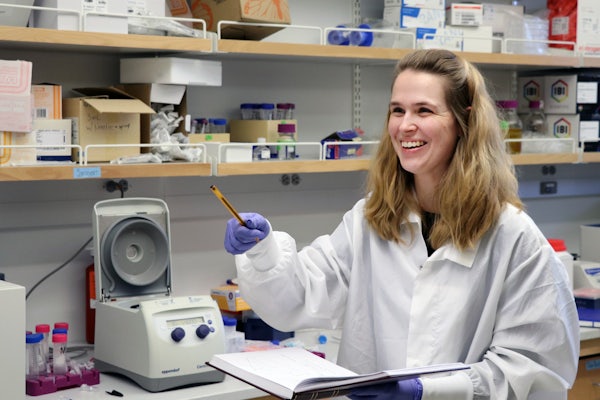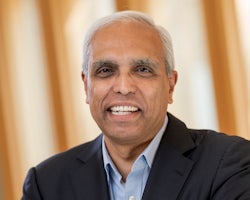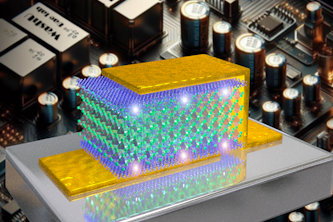Center for Biomolecular Condensates attracts collaborators from around the world
After meeting Rohit Pappu at a conference last summer, Nadia Erkamp joined Pappu’s lab as a visiting researcher

When the Center for Biomolecular Condensates launched last fall, director Rohit Pappu, the Gene K. Beare Distinguished Professor in biomedical engineering in the McKelvey School of Engineering at Washington University in St. Louis, knew it would be a game changer, both in terms of the cutting-edge research the Center would support and the collaborations it would cultivate.
“A key mission of the Center for Biomolecular Condensates is to develop technologies, uncover the relevant physical principles and apply these to study and understand how condensates function in live cells,” Pappu said at the Center’s kickoff symposium Oct. 14, 2022. “This is one of the more important topics in cell biology today and one that is attracting attention across disciplines.”
“We’re creating an environment for trainees from around the world to spend time with us in the center,” Pappu said. “It’s not just about a collaboration of center members, but centers and bodies globally and setting up strategic alliances with biotech companies, pharma companies and more.”
The Center’s broad-reaching themes, including studying the physics and physical chemistry of phase transitions, reverse engineering condensates, developing technologies to measure condensates’ structure and material properties, and creating synthetic condensates, make interdisciplinary collaboration across institutions a natural fit. And, indeed, Pappu has already started cultivating those relationships at internationally renowned institutions like the University of Cambridge.
That’s where Nadia Erkamp, a doctoral student working with Tuomas Knowles, met Pappu. After connecting with Pappu at a summer conference, Erkamp reached out about visiting WashU and the Center for Biomolecular Condensates where she was eager to approach condensate research from a different angle than she had done in Cambridge.
In this Q&A, Erkamp shares what makes biomolecular condensates so fascinating to her as well as an inside look at the Center where she’s found a welcoming home away from home.
How did you get into studying biomolecular condensates?
In the Netherlands, where I was an undergraduate student, I was studying biophysics and looking for a new, exciting field that would be a good direction for my future research. My adviser pointed me to biomolecular condensates, which is an expanding field with many fundamental questions yet to be answered.
Our body contains organs which perform different functions. Similarly, our cells have organelles with different functions. We know now that some of these organelles are biomolecular condensates. They don’t have a lipid membrane around them, so they are structures that your cells can relatively easily form and dissolve again as needed. We still have a lot to learn about what these condensates do in cells, how they form and how they're structured.
What attracted you to the Center for Biomolecular Condensates?
I met Rohit Pappu at a conference and was really drawn to his idea to build a center focused on promoting more collaboration and research in this area. At that time, I had been working on my PhD at Cambridge in the UK for two years, and I was looking for new people to work with and new things to learn. It was perfect timing for me to go work with a different group in a different place. I will be here for half a year to collaborate with new people, share my knowledge and learn.
What are you most excited to accomplish during your time in McKelvey Engineering?
I’m most excited to collaborate with researchers here. Luckily, from the moment I arrived, people have been very enthusiastic about discussing their research and working together. I’m also excited to be producing new original research. In fact, only two months into my visit, we have already produced a paper that is now available as a preprint online, which is a big accomplishment.
In terms of scientific goals, we're looking at the role that acidity plays for biomolecular condensates, and I’m thrilled to be a part of that. The research that's being done here on condensates is really famous internationally. For example, my colleagues at Cambridge would refer to WashU as the place where they established the stickers and spacers model. Researchers at the University of Cambridge have always been interested in the research that's being done here, but we have not collaborated much before. It's very exciting that the Center for Biomolecular Condensates is making this collaboration possible.
What’s your favorite thing about WashU so far?
The people! Everyone has been so welcoming. To give you an example, my colleagues got me a present for a holiday called “Sinterklaas.” This is a holiday in the Netherlands, where I grew up, but not in the United States, so I was surprised they got a gift to celebrate! It was very thoughtful.
Before starting at WashU, I felt a bit unsure about moving here for six months and taking a break from research at Cambridge. When you visit a new lab, you hope that you’ll find people to work with on interesting problems, but that isn’t a given. Luckily, everybody has been extremely happy to share what they're working on and involve me in things. The people I've met here have been really fantastic.
What’s something surprising about your field that you wish more people knew?
When I was in high school, I learned about cells in biology class. We were shown a scheme of a cell containing a nucleus, mitochondria and other components. Now, we know that there is a lot to be added to that picture: biomolecular condensates! Understanding how they function may help us find treatment or preventative measures for neurodegenerative diseases. It is exciting to work in an emerging field and find that condensates are relevant for a wide variety of cellular processes and materials. Thus, I am very grateful to approach this topic from a new angle here at WashU with the researchers at the center for biomolecular condensates.




